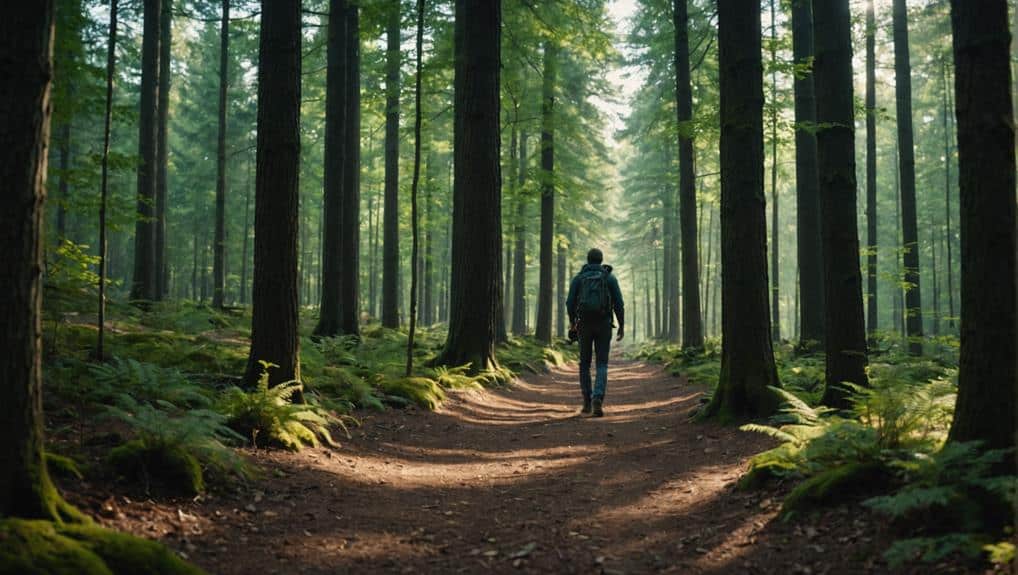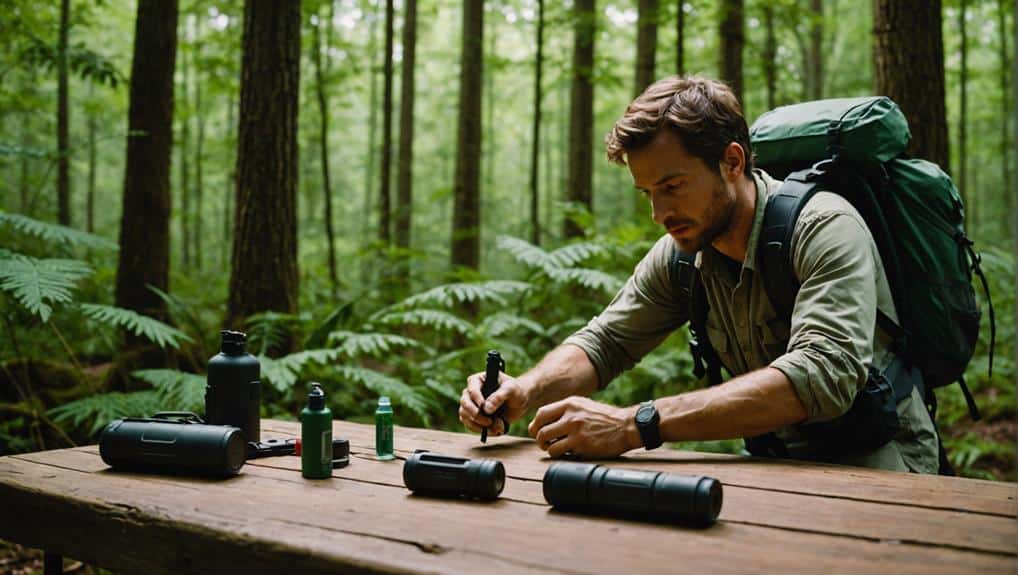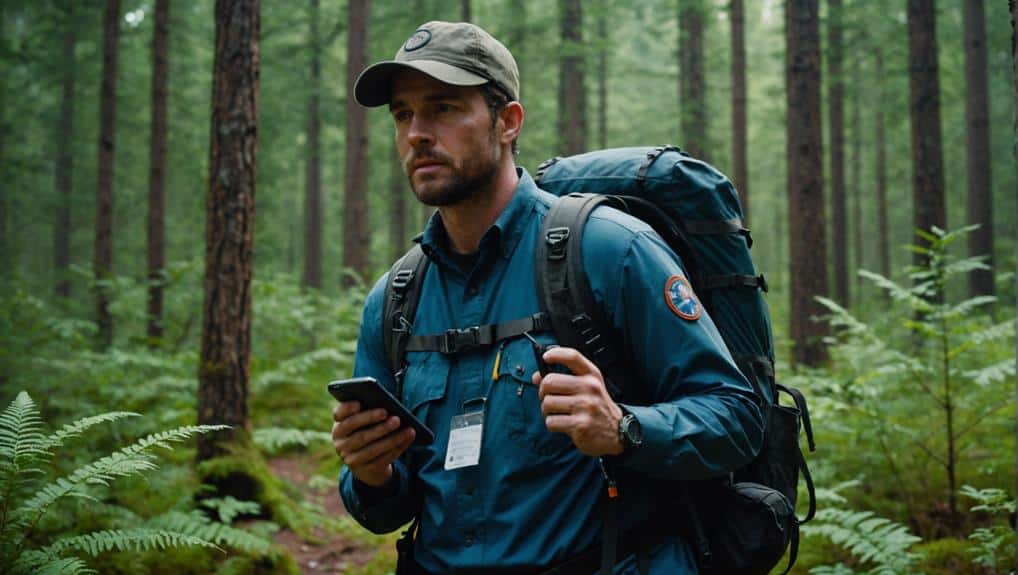When you’re out exploring nature’s wonders,
keeping safe tops your list. Picture yourself hiking, breaths deep with mindfulness, scanning for anything off. A
trusty whistle around your neck and pepper spray clipped on your belt, you feel ready for anything. You notice a rustle—more than just leaves—and trust your gut by preparing a
defense move. Learning strikes like palm hits and knee jabs empowers you, especially for critical spots like the nose or groin. At camp, setting up away from water with
bear-proof containers keeps you and your snacks safe. Curious how tech, drills, and wildlife tips can boost your confidence out there?
Situational Awareness
When you’re out enjoying
outdoor sports,
situational awareness is your first line of defense. It’s essential to always be conscious of your surroundings, whether you’re hiking, camping, or just exploring. By honing your observation skills, you can spot
potential threats before they become real dangers. Notice the rustle of leaves or a sudden silence—those might be signs of wildlife or even other people.
Practicing
mindfulness techniques helps keep you alert. Take a moment to breathe deeply and scan your environment. This isn’t just about looking around; it’s about truly seeing and understanding what’s happening. Regular
environment assessment can help you pick up on subtle changes, like a new set of footprints on a trail or an unusual animal behavior.
Knowing how to
predict and respond to risks empowers you to handle emergencies confidently. Imagine this: you notice an unfamiliar figure approaching your campsite. Instead of panicking, your situational awareness skills kick in, guiding your response. Training in
emergency management gives you the tools to act decisively.
Basic Self-Defense Moves
When it comes to basic
self-defense moves, you’ll want to focus on targeting
vulnerable areas like the eyes, nose, throat, and groin to throw an attacker off balance and give yourself a chance to escape. Use your body weight to your advantage with techniques like hip throws or shoves, making each movement count without wearing yourself out. Don’t forget to practice the
palm strike—it’s a powerful, safe way to defend yourself without risking injury to your hand.
Essential Defensive Techniques
In any situation where personal safety is at risk, mastering essential defensive techniques can make all the difference. When you’re out in nature, being prepared with effective self-defense techniques is vital. The “3 P’s”—Prepare, Protect, and Prevent—offer a solid foundation. Prepare by knowing your essential items, like a whistle or pepper spray, and practicing gross motor skills such as striking and escaping holds. Protect yourself with techniques like the palm strike and knee strike, which use your body’s natural power to incapacitate an attacker quickly. Prevent by maintaining situational awareness, always scanning your surroundings for potential threats.
Here’s a quick rundown of basic defensive techniques you should know:
- Palm Strike: Use the heel of your hand to target an attacker’s nose or chin. It’s powerful and easy to execute.
- Knee Strike: Aimed at the groin or midsection, this move uses your lower body strength to create maximum impact.
- Verbal Assertiveness: Sometimes, projecting confidence and authority can deter an attacker. Shouting “Back off!” can make them think twice.
Situational Awareness Tips
Imagine you’re hiking through a dense forest; the tranquility is profound, but so should be your awareness. Staying alert is your first line of defense. Regularly scan your surroundings, noticing anything unusual or out of place. Trust your instincts—if something feels off, it probably is. Don’t hesitate to take proactive steps to guarantee your safety.
Using your voice can be a powerful deterrent. Practice assertive verbal communication; a loud, confident shout can scare off potential threats and alert others nearby. Remember, it’s not just about shouting, but conveying confidence and determination.
Physical defense basics are essential. Learning simple moves like palm strikes and knee strikes can make all the difference in an emergency. These techniques don’t require extensive training and can be executed quickly if needed.
Here’s a quick emotional guide to situational awareness:
| Emotion |
Action |
Outcome |
| Nervous |
Scan surroundings |
Increased awareness |
| Uncomfortable |
Trust your gut |
Proactive safety measures |
| Confident |
Use your voice |
Potential threat deterred |
| Determined |
Learn defense basics |
Quick, effective self-defense |
| Vigilant |
Practice awareness regularly |
Enhanced response ability |
Stay alert, trust your instincts, and use your voice. This thorough guide guarantees you’re ready for any situation.
Emergency Response Actions
Grasping basic self-defense moves can greatly boost your confidence and safety during outdoor activities. When you’re out on the trails or setting up camp, knowing how to react in high-stress outdoor situations can make all the difference.
First off, familiarize yourself with some key emergency response actions:
- Palm Strike: Aim for the attacker’s nose or chin. A well-placed palm strike can disorient them, giving you a chance for a quick escape.
- Jab and Cross Punch: These strikes help you maintain balance and put an aggressor on the defensive. Practice regularly to build muscle memory.
- Using Surroundings: Grab a stick or rock as a defensive tool if needed. Sometimes, nature offers the best self-defense options.
Adding verbal assertiveness to your strategy is essential. Yelling phrases like “Back off!” can deter potential threats and attract attention. The key is to be loud and confident, making it clear that you won’t be an easy target.
Don’t forget to practice self-defense drills. This will help enhance your reaction time and make sure you stay sharp. Remember, preparation is your best ally in keeping safe during your outdoor adventures!
Personal Safety Gear
When you’re out enjoying the great outdoors, having the right
personal safety gear can make all the difference between a great adventure and a nightmare. Essentials like a whistle for signaling distress, a
tactical flashlight, and a personal alarm can help you stay safe and ward off potential threats. Consider carrying a
3 IN 1 130db PERSONAL ALARM WITH LIGHT for added security—it’s lightweight and easy to use. And don’t forget
wearable safety devices like smartwatches with SOS features—they’re like having a lifeline on your wrist
Essential Protection Tools
For outdoor sports lovers, ensuring personal safety is paramount, and essential protection tools can make all the difference. When you’re out on a trail or setting up camp, having the right gear can keep you safe and give you peace of mind. Let’s explore some indispensable tools you shouldn’t leave home without.
- Personal Alarms: Compact and lightweight, personal alarms are a must-have. They emit loud sounds, typically over 120 dB, to deter attackers and attract attention. You can easily attach one to your durable backpack or carry it in your pocket.
- Pepper Spray: This trusty sidekick can incapacitate an attacker by causing temporary blindness and breathing difficulties. Keep it handy in a side pocket of your backpack or attach it to a self-defense keychain for quick access.
- Tactical Flashlights: Equipped with high lumens, these flashlights can light up the darkest trails and have a strobe function to disorient potential threats. They’re not just for lighting the path; they’re a powerful deterrent.
Don’t forget to download some personal safety apps. These can provide location tracking and emergency alerts, adding an extra layer of security to your adventures. Stay safe and enjoy the great outdoors!
Wearable Safety Devices
In today’s world, staying safe during outdoor adventures is easier than ever thanks to wearable safety devices. Whether you’re hiking the backcountry or setting up camp by a serene lake, these gadgets help you stay connected and secure. Personal alarms and GPS trackers are your first lines of defense, providing immediate alerts to potential threats. With a simple push of a button, smartwatches equipped with emergency SOS features can send your location to emergency contacts, ensuring help is on the way.
Imagine you’re hiking and suddenly take a tumble. No worries—wearable safety devices with fall detection can automatically notify emergency services. These devices are designed to be lightweight and waterproof, so you won’t even notice you’re wearing them, and they won’t weigh down your backpack. Plus, as technology evolves, features like two-way communication and mobile app integration keep you informed and connected.
Here’s a quick look at some key features:
| Feature |
Benefit |
Example Device |
| Personal Alarms |
Immediate alert to threats |
Keychain Alarm |
| GPS Trackers |
Share your location |
Smartwatch with GPS |
| Emergency SOS Features |
Quick access to help |
Smartwatch |
| Fall Detection |
Automatic emergency notification |
Fitness Tracker |
| Lightweight & Waterproof |
Comfort and durability |
Smart Bracelet |
Stay safe, stay connected, and enjoy your outdoor adventures with peace of mind!
Safe Campsite Setup
Ever wondered how to guarantee a safe and comfortable campsite setup? It’s all about picking the right spot and following some simple guidelines. First off,
choose the right location. You should be at least 200 feet away from water sources. This minimizes environmental impact and keeps you away from potential flooding.
When it comes to
comfort and safety, look for flat, dry ground free of rocks, roots, and debris. Nobody wants a rock digging into their back at 2 AM! Also, setting up near natural windbreaks like trees or hills gives you protection from the elements.
Remember these three key steps for a
safe campsite setup:
- Choose the Right Spot: Verify your tent has good visibility and is away from water sources.
- Comfort and Safety: Find flat, dry ground and natural windbreaks.
- Store Food Securely: Use bear-proof containers or hang food 10 feet off the ground and 4 feet from the trunk.
Don’t forget the
Leave No Trace principles. This means packing out all trash and minimizing your impact on the environment. By following these tips, you’ll enjoy a safe, cozy, and environmentally friendly campsite.
Defensive Hiking Strategies
When you’re out on the trail, it’s crucial to stay vigilant and prioritize your safety. Start by ramping up your
situational awareness—regularly scan your surroundings, noting the presence of other hikers or
local wildlife. This isn’t just about seeing; it’s about absorbing your environment.
Pack a
personal safety device. A whistle or pepper spray can be a lifesaver, giving you a way to deter potential threats or signal for help. Your camping gear should also include essentials like a
first-aid kit and a map. Consider adding
Guard Alaska Bear Spray to your kit for enhanced protection against wildlife encounters.
Don’t forget to learn
basic self-defense moves. Simple techniques that use your body weight can be super effective. Think big, gross motor skills—like pushing or striking—that you can actually pull off under stress.
Familiarize yourself with local wildlife before you go. Know what to do if you encounter a bear or snake. It’s not just about avoiding them; it’s about reacting correctly if you do meet one.
Lastly, always have an
emergency plan. Inform someone of your
hiking route and estimated return time. It’s not just about being prepared; it’s about ensuring someone knows where you are in case things go south. Stay safe and
enjoy the trail.
Encountering Wildlife
While out in nature, you might come across various wildlife, and it’s vital to know how to handle these encounters safely. Imagine you’re hiking and suddenly, a bear appears on the trail. Your heart races but remember to maintain distance—at least 100 yards. Bears, like moose, can be unpredictable. Make yourself look bigger, speak in a calm but firm voice, and slowly back away, never turning your back.
But bears aren’t the only concern. Snakes can be sneaky! If you encounter one, just stay still and give it plenty of space. Most snakes won’t strike unless cornered or provoked.
To keep yourself safe, follow these guidelines:
- Maintain distance: Always keep a safe distance from wildlife to avoid provoking them.
- Never feed: Feeding wildlife disrupts their natural habits and can lead to dangerous habituation.
- Local behavior: Familiarize yourself with the behavior of local wildlife and the specific risks in the area.
Understanding local behavior is important, whether it’s recognizing signs of nesting birds or active dens. Nature is majestic but unpredictable, so stay informed and stay safe! Remember, you’re a guest in their home.
Emergency Communication
Charting the great outdoors requires more than just physical preparedness; having a
reliable means of
emergency communication can be a lifeline. Imagine you’re deep in the woods, your phone’s battery plummeting faster than a rock climber without ropes. That’s why you should carry a
fully charged mobile phone with emergency contacts saved. And don’t forget a
portable power bank for those extended trips where charging options are as scarce as Wi-Fi in a cave.
For those remote areas where cell service is a myth,
satellite communication devices, like a Garmin inReach or SPOT, are game changers. They allow for
two-way messaging and can send distress signals, making certain you’re never truly alone out there.
Familiarize yourself with
local emergency numbers and protocols, as they might not be the same as back home. It’s also smart to invest in a whistle, a small but mighty tool for signaling for help. Its shrill sound can carry much further than your voice.
Before you head out,
inform someone of your plans, including your expected route and return time. It guarantees that if you don’t return as scheduled, help will be on the way.
Training and Practice
Mastering self-defense for outdoor sports involves more than just knowing techniques; it requires consistent training and practice. You can’t just read about how to defend yourself and expect to be prepared. Regularly practice your self-defense moves in various outdoor settings. This means getting out on the trails, into the woods, or wherever you might find yourself during your adventures. Familiarity with your environment can drastically improve how you respond to potential threats.
Engage in scenario-based training that mimics real outdoor situations. Imagine you’re hiking alone and unexpectedly encounter a stranger. How do you react? These scenarios boost your decision-making skills and confidence.
Here are three key practices to include in your training routine:
- Physical Drills: Focus on strength, agility, and endurance. Think about running up steep hills or traversing rocky terrain while practicing your maneuvers.
- Mental Rehearsals: Visualize different self-defense scenarios and how you’d handle them. This mental prep can be just as important as physical training.
- Workshops and Classes: Attend outdoor self-defense workshops where experienced instructors teach practical skills and strategies tailored for outdoor enthusiasts.
Consistency is key. Keep practicing, and you’ll be ready to handle anything that comes your way.
Frequently Asked Questions
How Can I Remain Calm During a Potential Threat While Outdoors?
Did you know 70% of people feel calmer using breathing techniques? To stay calm, practice situational awareness, mental visualization, grounding exercises, and positive affirmations. Have an emergency plan ready to boost confidence and maintain control.
What Are the Best Ways to De-Escalate a Confrontation with Another Person?
You can de-escalate a confrontation by using verbal techniques, maintaining calm body language, practicing active listening, and employing an empathy approach. Respect personal space and focus on conflict resolution to diffuse tension effectively. Always prioritize safety and understanding.
How Should I Handle Suspicious Behavior from Fellow Campers or Hikers?
If you notice suspicious actions from fellow campers or hikers, pay close attention to their body language and group dynamics. Maintain strong situational awareness, set clear personal boundaries, and use communication cues to assert yourself confidently.
What Are the Signs That Indicate I Should Leave an Area Immediately?
You might think it’s overreacting but trust your instincts. If you experience wildlife encounters, sudden weather changes, unusual noises, unfamiliar trails, lost navigation, or aggressive individuals, leave the area immediately to guarantee your safety.
How Can I Discreetly Signal for Help Without Drawing Attention?
You can discreetly signal for help by using hand signals, whistle techniques, or reflective devices. Mobile apps with emergency codes are useful too. Visual signals like flashing a light can alert others without drawing unwanted attention.








